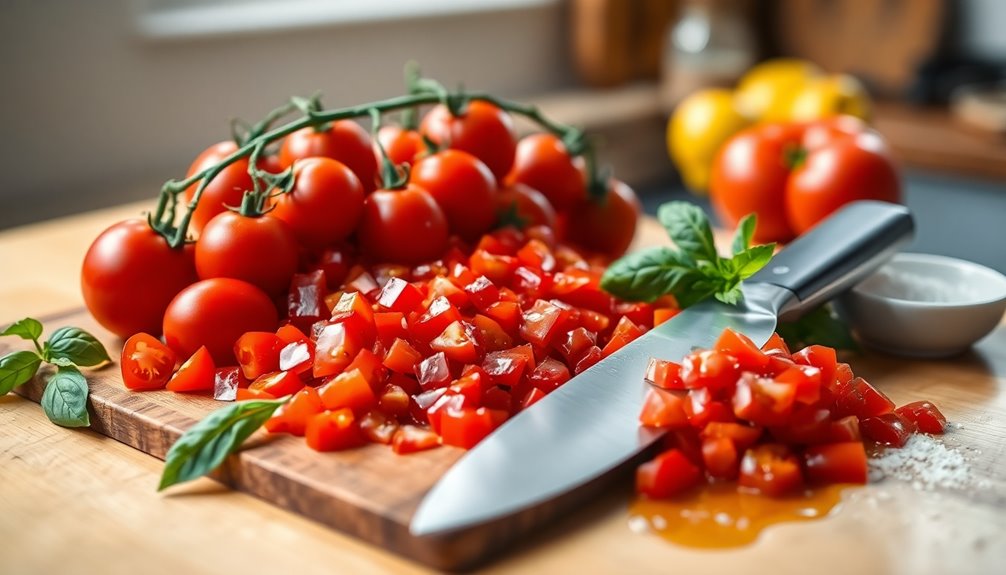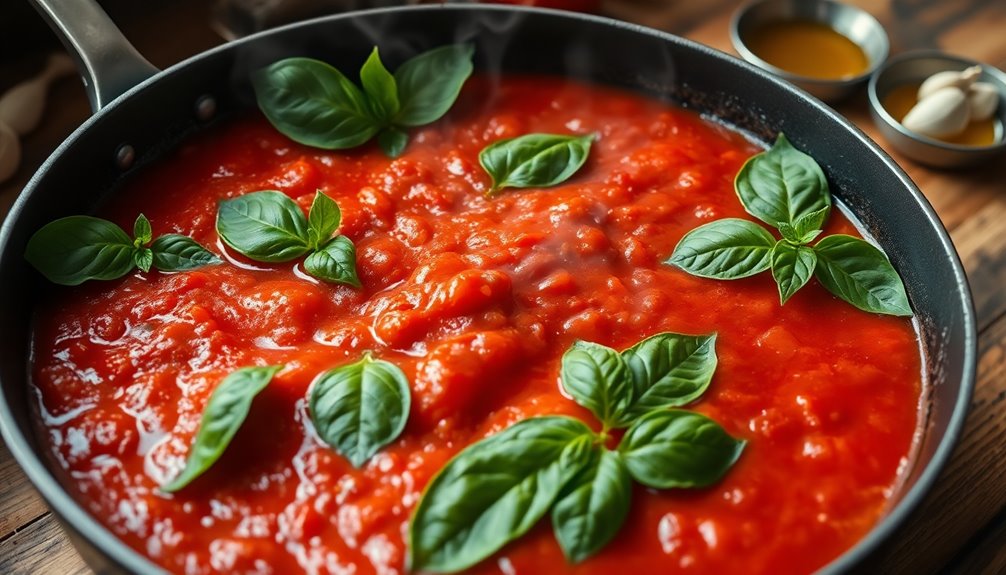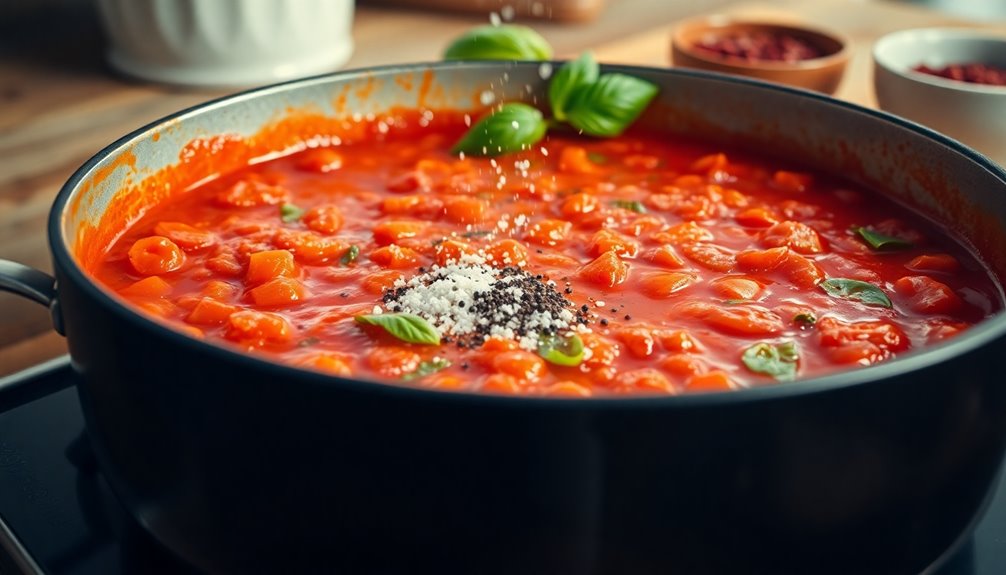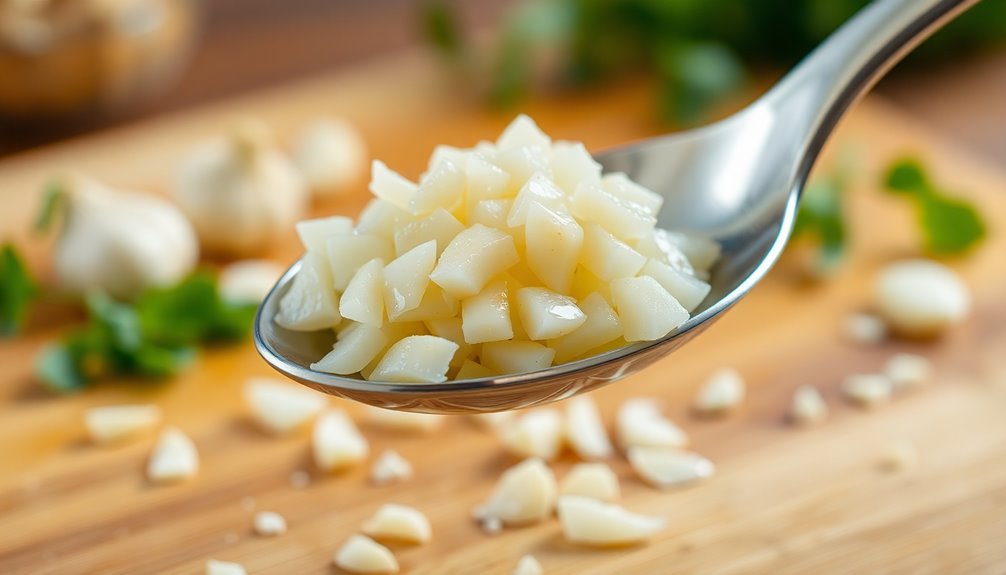You can make a delicious marinara sauce with just a few fresh ingredients. Start by finely chopping ripe tomatoes and sautéing minced garlic in olive oil until fragrant. Add fresh basil, and if you like, a pinch of oregano and red pepper flakes for extra flavor. Simmer the mixture on low for about 30 minutes, stirring occasionally, until thickened. Finally, season with salt and pepper to taste. This versatile sauce is perfect for pasta, pizza, or as a dip. For more tips on customizing and storing your marinara sauce, keep exploring.
Key Takeaways
- Start with high-quality fresh tomatoes or canned San Marzano for a flavorful base.
- Sauté minced garlic in olive oil to create an aromatic foundation for the sauce.
- Simmer the sauce for 30 minutes to deepen flavors and achieve desired thickness.
- Stir in fresh basil towards the end for enhanced aroma and taste.
- Season with salt and pepper to balance flavors, and customize with herbs or spices as desired.
History

The history of marinara sauce is as rich and flavorful as the dish itself.
You'll find its origins trace back to 18th-century Naples, where sailors sought a quick, hearty meal after long voyages. The simple combination of tomatoes, garlic, and olive oil became a beloved staple.
As tomatoes gained popularity in Europe, they transformed Italian cuisine, leading to the creation of marinara. You might be surprised to learn that the name "marinara" means "sailor" in Italian, reflecting its maritime roots.
Over time, this sauce evolved, incorporating ingredients like basil and oregano, which added depth.
Today, marinara sauce is a cornerstone in Italian cooking, enjoyed worldwide, whether you're topping pasta or using it as a dip.
Recipe

Marinara sauce is a classic Italian tomato sauce that's both simple to make and packed with flavor. Traditionally made with ripe tomatoes, garlic, and fresh herbs, this sauce can be used in a variety of dishes, from pasta to pizzas, or simply as a dipping sauce. Making your own marinara sauce at home not only allows you to control the ingredients, but it also fills your kitchen with a delightful aroma that store-bought versions just can't replicate.
To create the perfect marinara sauce, the key is to use high-quality ingredients. Opt for fresh tomatoes when they're in season, or use canned San Marzano tomatoes for consistent flavor year-round. Pair these with aromatic garlic, a splash of olive oil, and a handful of fresh basil to elevate the sauce's taste. The beauty of marinara is its versatility; you can customize it by adding red pepper flakes for heat, or even a splash of red wine for depth.
Ingredients:
- 2 tablespoons olive oil
- 4 cloves garlic, minced
- 1 can (28 ounces) San Marzano tomatoes, crushed
- 1 teaspoon salt
- 1/2 teaspoon black pepper
- 1 teaspoon sugar (optional)
- 1/4 cup fresh basil, chopped
- 1 teaspoon oregano (optional)
In a large skillet, heat the olive oil over medium heat. Add the minced garlic and sauté for about 1 minute until fragrant, being careful not to let it burn.
Next, add the crushed tomatoes, salt, black pepper, and sugar if desired. Stir the ingredients together, bringing the sauce to a gentle simmer. Let it cook uncovered for 20-30 minutes, stirring occasionally, until it thickens to your liking. As the sauce simmers, its flavors will meld beautifully, creating a rich and vibrant base for your dish. For those looking to elevate their culinary skills, this cane’s sauce homemade recipe is an excellent choice that can be customized with various herbs or spices. Once the sauce has reached your desired thickness, taste it one last time to adjust the seasoning before serving it over your favorite pasta or dish.
In the final few minutes of cooking, stir in the fresh basil and oregano if using, allowing the flavors to meld together.
When making marinara sauce, remember that the longer it simmers, the more developed the flavors will be. Additionally, feel free to experiment with different herbs and spices to suit your taste.
If you prefer a smoother sauce, you can use an immersion blender to puree it to your desired consistency. Ultimately, this sauce can be stored in an airtight container in the refrigerator for up to a week, or frozen for longer storage, making it a convenient option for quick meals.
Cooking Steps

Now that you have your ingredients ready, it's time to start cooking your marinara sauce.
Begin by chopping the fresh tomatoes finely and sautéing the garlic in olive oil to build that rich flavor.
Once that's done, you'll add the basil and let it all simmer for a delicious finish.
Step 1. Chop Fresh Tomatoes Finely

Start by selecting ripe, juicy tomatoes for the best flavor in your marinara sauce.
Once you've got your tomatoes, rinse them under cool water to remove any dirt.
Next, slice each one in half and scoop out the seeds if you prefer a smoother sauce.
Place the halves cut side down on your cutting board.
Using a sharp knife, chop the tomatoes into small, even pieces. Aim for a fine dice, as this will help the tomatoes cook down nicely and blend into the sauce.
Remember, the smaller the pieces, the better the texture of your final dish.
Once you're done chopping, set the tomatoes aside and get ready for the next step in creating your delicious marinara sauce.
Step 2. Sauté Garlic in Olive Oil

After chopping your fresh tomatoes, the next step is to bring out the rich flavors that will form the base of your marinara sauce.
Start by heating a couple of tablespoons of olive oil in a medium saucepan over medium heat. Once the oil shimmers, add finely minced garlic.
Stir it gently as it cooks, allowing it to infuse the oil without burning. You'll want to sauté the garlic for about 1 to 2 minutes, or until it turns golden and fragrant.
Be careful not to let it brown too much, as burnt garlic can add bitterness to your sauce.
Once it's ready, you can move on to incorporating your fresh tomatoes, letting the flavors meld beautifully.
Step 3. Add Fresh Basil Leaves

Adding fresh basil leaves elevates your marinara sauce with a burst of aromatic flavor.
Once your garlic is sautéed and fragrant, it's time to incorporate the basil. Take a handful of fresh basil leaves, washing them gently under cool water to remove any dirt. Pat them dry with a clean kitchen towel.
Stack the leaves, roll them tightly, and slice them into thin ribbons, a technique known as chiffonade. Add the freshly cut basil to your sauce, stirring it in gently to distribute the flavor.
You'll notice the vibrant green color and enhanced aroma instantly. Remember, the best time to add basil is towards the end of cooking to preserve its fresh taste and color.
Enjoy the delightful transformation!
Step 4. Simmer Sauce for 30 Minutes

As the flavors meld together, simmer your marinara sauce for 30 minutes to deepen its taste and achieve a perfect consistency.
Set your heat to low, allowing the sauce to bubble gently. Stir occasionally to prevent it from sticking to the bottom of the pot.
This slow cooking process lets the tomatoes break down, releasing their natural sweetness, while the garlic and onion infuse their savory notes throughout.
You'll notice the sauce thickens, transforming into a rich, vibrant red. Keep an eye on the texture; it should be smooth but not overly thick.
If it gets too thick, feel free to add a splash of water or broth to reach your desired consistency before serving.
Enjoy the aroma!
Step 5. Season With Salt and Pepper

Once your marinara sauce has simmered and thickened to a rich consistency, it's time to enhance its flavor.
Start by adding a pinch of salt. It's best to sprinkle it in gradually, tasting as you go to guarantee you don't overdo it. Salt brings out the natural sweetness of the tomatoes and balances the acidity.
Next, add freshly cracked black pepper for a subtle kick. Like the salt, add it in small increments, tasting after each addition. The goal is to complement the sauce without overpowering its fresh ingredients.
If you want a bit more depth, consider adding a pinch of red pepper flakes.
Once you're satisfied with the seasoning, give it a final stir and enjoy your delicious marinara!
Final Thoughts

While crafting your marinara sauce, remember that the beauty of this dish lies in its simplicity and versatility. You can easily adapt the recipe to suit your taste or dietary needs, whether you prefer a chunky texture or a smooth finish.
Don't hesitate to experiment with herbs, spices, or even add a splash of red wine for depth. Fresh ingredients make all the difference, so opt for the ripest tomatoes and aromatic garlic.
Once you've perfected your sauce, use it as a base for pasta, pizza, or any dish that calls for a rich, flavorful sauce. Enjoy the process, and share your creations with loved ones.
Your homemade marinara isn't just a recipe; it's a delicious way to connect with others.
Frequently Asked Questions
Can I Freeze Marinara Sauce for Later Use?
Absolutely, you can freeze marinara sauce for later use!
Just make sure it's cooled down before transferring it to airtight containers or freezer bags.
Portioning it out can help you thaw only what you need.
Label the containers with the date, and it'll stay fresh for about three to six months in the freezer.
When you're ready to use it, simply thaw in the fridge or heat directly from frozen.
Enjoy!
What Type of Tomatoes Are Best for Marinara Sauce?
When you're choosing tomatoes for marinara sauce, go for San Marzano or Roma tomatoes.
These varieties have fewer seeds and thicker flesh, which means they'll give you a rich, flavorful sauce.
If you can't find those, look for any high-quality canned tomatoes; they often work great too.
Just make sure they're labeled as "whole" or "crushed" to get that perfect texture.
You'll notice the difference in taste and consistency!
How Long Does Homemade Marinara Sauce Last in the Fridge?
Homemade marinara sauce typically lasts about 4 to 5 days in the fridge.
To make sure it stays fresh, store it in an airtight container.
If you won't use it within that time, consider freezing it; it can last up to 6 months in the freezer.
Just remember to label your container with the date, so you know when to use it.
Enjoy your cooking and savor the flavors of your homemade sauce!
Can I Add Meat to My Marinara Sauce?
Absolutely, you can add meat to your marinara sauce! Ground beef, sausage, or even meatballs work great for enhancing flavor and texture.
Just brown the meat in a pan before mixing it into your sauce. It'll take a bit longer to cook, but the result will be delicious.
Experiment with different meats and seasonings to find your perfect combination. You'll love how it elevates your sauce to a whole new level!
What Herbs Pair Well With Marinara Sauce?
When you're looking to enhance the flavor of your dish, consider adding herbs like basil, oregano, and thyme.
These herbs bring a fresh, aromatic quality that really complements the sauce. You might also experiment with parsley for a bit of brightness or a touch of red pepper flakes if you like some heat.
Just remember to adjust the quantities to suit your taste, and you'll create a deliciously herb-infused experience.










